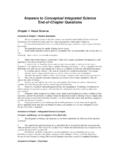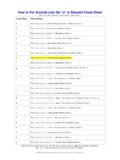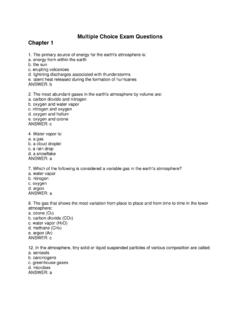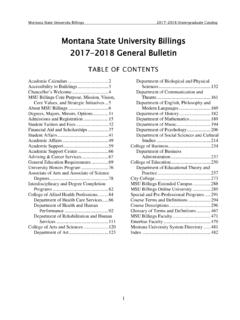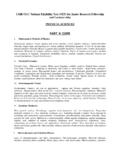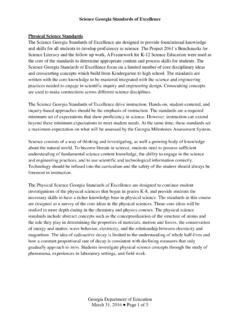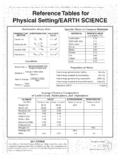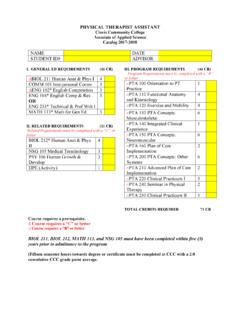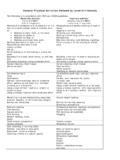Transcription of Introducing Physical Geography - MSU Billings
1 SyllabusIntroduction to Physical GeographyGPHY 111 Instructor: Dr. Neil (406) 896-5931 Office: Science 118 Office Hours: Mondays and Fridays: 9-11, and of course by meets in the Science Auditorium Tuesdays and Thursdays, 10:30-12:00 pmRequired Texts: Introducing Physical Geography , 4thEd.,Strahler and Strahler, Wiley, Map of MontanaAt times there may also be other handouts and readings Grading: Homework 15%Exams: 3 midterms + Final 80%Class Participation5%Homework is ungraded, , you either get credit or you don t. However, I may ask you to redo an assignment if I think it is not up to snuff. Homework will generally be short (sometimes mindless) exercises intended to reinforce basic knowledge and ideas. Someof these will involve reproducing visual overviews found at the beginning of many of our textbook s chapters. Homework may include a Physical Map of the World, Mountain ranges of the world, Maps of Climate Zones, Land Use, Wind Patterns, Ocean Currents, factorsaffecting Climate Change etc.
2 It would probably be a good idea to get some colored pencils or pens for the homework. These will also be helpful in the will generally posted in the morning at: can be printed out at no charge at several MSU-B facilitiesFor learning basic geographic facts and names check out: #/video/weather/2010/01/13 Physical Geography Introducing Geography Spheres, Systems, Cycles and Trends Physical Geography , Environment, and Global ChangeIntroducing GeographyGeography can be subdivided into human geographyand Physical geographyhuman geographyexamines economic, social and behavioral processes Physical geographyexamines natural processesGeographic fields of studyThey all interactSpheres, Systems and CyclesThe natural spheres :Lithosphere,Hydrosphere, (Teilhard de Chardin)No sphere(Facebook)Spheres, Systems and CyclesThe life layeris the shallow Earth surface layer where the four realms (or spheres) interact and where mostlife forms are found lithosphereHydrosphereAtmosphereBiospher eSpheres, Systems and CyclesScale, pattern andprocessare three interrelated geographic themesScale: the level of structure or organization at which a phenomenon is studiedPattern: variation in phenomenon observed at a particular scale, diurnal (day-night) cycles, El Ni o, Atlantic : how the factors that affect a phenomenon act to produce a pattern at a particular scaleExample.
3 Process (wind) >>>>Pattern (waves)Spatial ScalesProcesses in the four spheres are studied at different spatial scalesor levels of detail (global, continental, regional, local, individual, microscopic, )1000-Year Temperature RecordsGlobal Box , Figure 2 Regional LocalLocalNatural Systemsa systemis a collection of Physical processes that are linked and act together in an organized waya systems approachto Physical Geography looks for quantitativelinkages and interactions between processes and ratesthis is a kind of accounting!Feedbacks: Positive and NegativeCyclesCyclesare periodic changes in rates of processes that can occur on periods of any time , rotation of the Milky Way galaxy, revolution of the Earth about the Sun, daily rotation of the Earth about its axis, waves hitting a beach, a vibrating guitar string, the vibration of an Cyclesmusic of the spheresInterglacialGlacialMilankovitch CyclesEccentricity (~100 Ka)Orbital Obliquity (Axial tilt; ~41 Ka) and Precession (~26 Ka)TrendsTrends are long term monotonic changes in rates of , change in Sun s solar output, the rise of oxygen in the atmosphere, global warming.
4 Recent Increases in Carbon Dioxide Human activities have caused dramatic increases in greenhouse gas concentrationsThe Impact on Global TemperaturesPhysical Geography , Environment, and Global ChangePhysical Geography is also concerned with the relationships between humans and their environmentsEnvironmental changeis caused by both natural processes and human interference Some important topics of global change that Physical geographers are investigating are global climate change, the carbon cycle, biodiversity, pollution, andextreme events Basic ToolsMapsWhat can maps show us? Political boundariesIs this a map?Seasonal Air Temperature Patterns Stronger seasonal heating and cooling on land produces asymmetry Poleward distortion of isotherms over northern high latitude oceans Equatorward distortion over subtropicswintersummerClassification of Land VegetationSea Surface Temperature (SST) Physical featuresTectonic featuresVolcanic rocksMajor faults PrecipitationGeologic FormationsGeographic Information Systems (GIS)Geographers use specialized tools including maps, geographical information systems (GIS), remote sensing,mathematical modeling andstatisticsto allow them to portray information that varies spatially on the Earth s surfacep.
5 13 ProcessesExample:ConvectionHeat driven convection1. Bottom water is warmed2. It expands an is therefore less dense3. It rises to the surface and then spreads out4. Cooler water at the sides descends to fill the voidA convective thunderstormSome of the topics we will studyWeather and #/video/weather/2010/01/13 Energy BalanceEnergy In = Energy Out224(1)4 SRR T o18 CT But the observed Tsis about 15 CWhat s Missingfrom the 0-D energy balance model? Vertical structureThe greenhouse effect Energy storage and transportThe general circulation of the atmosphere and oceansIn other words, The Greenhouse Effect!Temperature Patterns Stronger seasonal heating and cooling on land produces asymmetry Poleward distortion of isotherms over northern high latitude oceans Equatorward distortion over subtropicsHow is Energy Transportedto its escape zones? Both atmospheric and oceantransport are crucial Buoyancy-driven convectiondrives vertical transport Latent heatis at least as important as sensible heatWhat a single cell convection model would look like for a non-rotatingearth Thermal convection leads to formation of convection cell in each hemisphere Energy transported from equator toward poles What would prevailing wind directionbe at the surface over N.
6 America with this flow pattern on a rotating earth?Coriolis EffectThe Coriolis Effect deflects moving objects to the right in the northern hemisphere and to the left in the Zones Circulation features are tied to regional climate Rising air associated with lots of precipitationPrecipitation (mm/month)JanuaryJuly Very wet over tropics Seasonal shift (N/S) Monsoon regions Extremely dry subtropical highs Midlatitudes get more summer rain July rainfall looks like a map of forest coverBiogeographyClassification of Land VegetationTectonics and LandformsRotatingGlo beLQ .mo North American Mobile BeltNorth American CratonShieldEastern North American Mobile BeltPlatformOcean-Continent convergenceNorthern Rocky MountainsYoungfolded and faulted mountainsChinese WallBob Marshal WildernessRocks and MineralsBiotite (mica)QuartzFeldsapr (albite)Tremolite (amphibole)Augite (inosilicate)GarnetImagine the first rock and the cycles that it has been PropertiesCrustDensityCompositionThickne ssAgecontinental~ g/cm3 FelsicThick:20-70 kmOld:up to4 Byrsoceanic~ g/cm3 MaficThin:2-10 kmYoung:<200 MysFlood basalts with several thick and thin layers.
7 Each layer represents a separate Batholiths:Half Dome; part of the Sierra Nevada batholithThe Hydrologic Cycle and Its ImpactRivers and LandslidesGlaciers, Glacial/Interglacial Cycles and Ice AgesAncient Moraines
